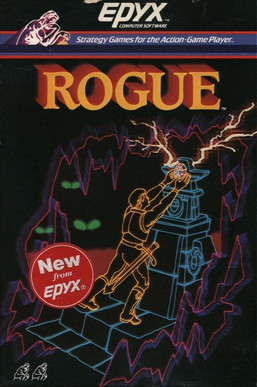
Rogue is a dungeon crawling video game by Michael Toy and Glenn Wichman with later contributions by Ken Arnold. Rogue was originally developed around 1980 for Unix-based minicomputer systems as a freely distributed executable. It was later included in the Berkeley Software Distribution 4.2 operating system (4.2BSD). Commercial ports of the game for a range of personal computers were made by Toy, Wichman, and Jon Lane under the company A.I. Design and financially supported by the Epyx software publishers. Additional ports to modern systems have been made since by other parties using the game's now-open source code.

Wizardry II: The Knight of Diamonds is the second game in the Wizardry series of role-playing video games. It was published in 1982 by Sir-Tech.

Curse of the Azure Bonds is a role-playing video game developed and published by Strategic Simulations, Inc (SSI) in 1989. It is the second in a four-part series of Forgotten Realms Advanced Dungeons & Dragons Gold Box adventure computer games, continuing the events after the first part, Pool of Radiance.

Temple of Apshai is a dungeon crawl role-playing video game developed and published by Automated Simulations in 1979. Originating on the TRS-80 and Commodore PET, it was followed by several updated versions for other computers between 1980 and 1986.

Eamon, sometimes known as The Wonderful World of Eamon, is a game creation system and a role-playing adventure game series created by Donald Brown and released for the Apple II in 1980. The game is a text adventure similar to other early titles like Adventure (1976) or Zork (1980) and to later text-based multi-user dungeons (MUDs), though with many role-playing elements not available in other interactive fiction. Eamon software is non-commercial and is freely available in the public domain.

The Virtual Theatre is a computer game engine designed by Revolution Software to produce adventure games for computer platforms. The engine allowed their team to script events, and move animated sprites against a drawn background with moving elements using a point-and-click style interface. Upon its first release, it rivaled competing engines like LucasArts' SCUMM and Sierra's Creative Interpreter, due to its then high level of artificial intelligence. The engine was first proposed in 1989, while the first game to use it, Lure of the Temptress, was released in 1992, followed by Beneath a Steel Sky (1994), Broken Sword: The Shadow of the Templars (1996) and Broken Sword II: The Smoking Mirror (1997).

Wizardry: Proving Grounds of the Mad Overlord is the first game in the Wizardry series of role-playing video games. It was developed by Andrew Greenberg and Robert Woodhead. In 1980, Norman Sirotek formed Sir-Tech Software, Inc. and launched a beta version of the product at the 1980 Boston Computer Convention. The final version of the game was released in 1981.
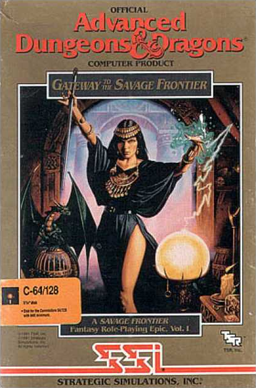
Gateway to the Savage Frontier (1991) is a Gold BoxDungeons & Dragons computer game developed by Beyond Software and published by SSI for the Commodore 64, PC and Amiga personal computers.

Wizardry III: Legacy of Llylgamyn is the third scenario in the Wizardry series of role-playing video games. It was published in 1983 by Sir-Tech.

Quest for Glory: So You Want to Be a Hero is a 1989 adventure game/role-playing game hybrid, designed by Lori Ann Cole and published by Sierra On-Line for MS-DOS. It is the first game in the Quest for Glory series, and has been credited for being a genre-defining game, as it tried to mix graphical adventure gaming with role-playing-like elements such as statistic building that would actually affect the ability to accomplish certain parts of the game. The game has a satirical and silly tone. Ports for the Amiga, Atari ST, and NEC PC-9801 were released in the early 1990s. A VGA remake, titled Quest for Glory I: So You Want to Be a Hero, was released in 1992 for DOS and later in 1994 for Mac OS.

Al-Qadim: The Genie's Curse is an action role-playing game for the personal computer set in the Al-Qadim campaign setting of Advanced Dungeons and Dragons. The game was developed by Cyberlore Studios and published in 1994 by Strategic Simulations (SSI). The game combines role-playing game and adventure with a simplified interface; the player's character is a young corsair trying to clear his family's name, rescue his betrothed and determine who has been freeing genies from their masters.
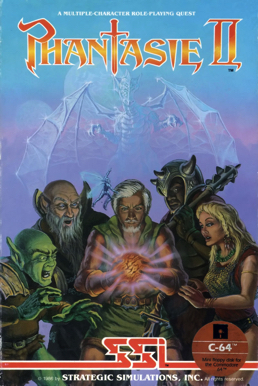
Phantasie II is the second game in the Phantasie series of role-playing video games.

World of Aden: Thunderscape is a swords & sorcery role-playing video game for MS-DOS compatible operating systems developed by Strategic Simulations and published by Mindscape in 1995. The game is based on the world described in the fantasy trilogy of the same name.

Telengard is a 1982 role-playing dungeon crawler video game developed by Daniel Lawrence and published by Avalon Hill. The player explores a dungeon, fights monsters with magic, and avoids traps in real-time without any set mission other than surviving. Lawrence first wrote the game as DND, a 1976 version of Dungeons & Dragons for the DECsystem-10 mainframe computer. He continued to develop DND at Purdue University as a hobby, rewrote the game for the Commodore PET 2001 after 1978, and ported it to Apple II+, TRS-80, and Atari 800 platforms before Avalon Hill found the game at a convention and licensed it for distribution. Its Commodore 64 release was the most popular. Reviewers noted Telengard's similarity to Dungeons and Dragons. RPG historian Shannon Appelcline noted the game as one of the first professionally produced computer role-playing games, and Gamasutra's Barton considered Telengard consequential in what he deemed "The Silver Age" of computer role-playing games preceding the golden age of the late 1980s. Some of the game's dungeon features, such as altars, fountains, teleportation cubes, and thrones, were adopted by later games such as Tunnels of Doom (1982).
Donald M. Brown is a programmer and the creator of Eamon, a long-running non-commercial role-playing game series for the Apple II computer first released in 1980.
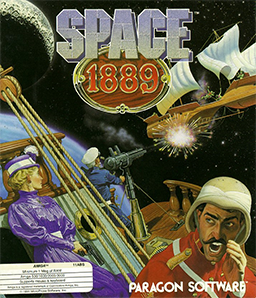
Space: 1889 is an adventure game developed by Paragon Software and published in 1990 for Amiga, Atari ST, and MS-DOS.

Beneath Apple Manor is a roguelike game written by Don Worth for the Apple II and published by The Software Factory in 1978. Higher resolution "Special Editions" were released in 1982 and 1983, through Quality Software, for the Apple II and Atari 8-bit family. It was one of the first video games to use procedural generation.

MegaTraveller 2: Quest for the Ancients is a 1991 space science fiction role-playing video game produced by Game Designers' Workshop licensee Paragon Software and distributed by MicroProse and Empire Software. It is the sequel to MegaTraveller 1: The Zhodani Conspiracy. Designed by Marc Miller, an original creator of the Traveller series, the game is set within the Official Traveller Universe and features a character creation system and other elements of game mechanics compatible with previous Traveller products. The game's plot centers on finding a way to stop the flow of slime issuing from an ancient ruin on the planet Rhylanor before it inundates the entire world. Gameplay involves controlling a party of up to five adventurers who engage in real-time exploration, trading, interaction with non-player characters, combat and problem solving on the surface of over a hundred planets and in spaceships journeying between these worlds.
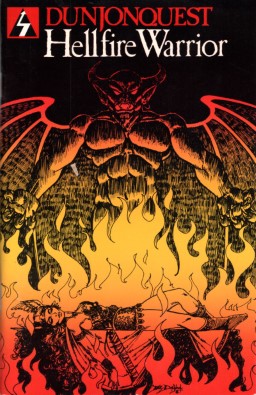
Hellfire Warrior is a dungeon crawl video game for the Apple II, Commodore PET, and TRS-80 published by Automated Simulations in 1980. An Atari 8-bit family port was released in 1982. Hellfire Warrior is the direct sequel to 1979's Temple of Apshai.
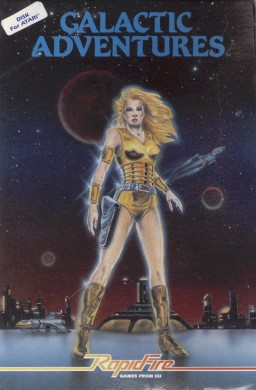
Galactic Adventures is a 1982 video game published by Strategic Simulations for the Apple II and Atari 8-bit family.



















